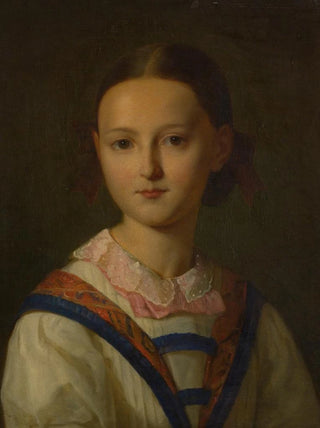Painting Portrait of a Young Girl - Friedrich von Amerling | Art print


View from behind

Frame (optional)
In the fascinating world of art, some works manage to capture the very essence of youth and beauty. The "Portrait of a Young Girl" by Friedrich von Amerling is one of those creations that, through its delicacy and expressiveness, transports the viewer into a realm filled with grace and poetry. This painting, created in the 19th century, perfectly illustrates the artist's skill in immortalizing the innocence and vitality of youth, while demonstrating remarkable technical mastery. Through this portrait, Amerling invites us to contemplate not only the face of a young girl but also the soul and dreams that inhabit her.
Style and uniqueness of the work
Friedrich von Amerling's style is characterized by fine execution and meticulous attention to detail. In "Portrait of a Young Girl," light plays a crucial role, illuminating the face of the young model with an almost supernatural softness. The delicate nuances of the skin, the reflections in the hair, and the subtlety of the shadows create an intimate atmosphere where the viewer feels almost complicit in this frozen moment in time. The composition, both simple and effective, highlights the subject without superfluous artifices, allowing the personality of the young girl to fully express itself. This portrait is a celebration of youth, where each brushstroke seems to whisper a story, a promise of the future.
The artist and his influence
Friedrich von Amerling, born in 1803 in Vienna, is one of the most renowned portraitists of his time. Trained in Vienna's art schools and influenced by the masters of the past, he developed a style that is uniquely his own, blending realism and romanticism. Amerling had a significant impact on portrait painting, inspiring many contemporary and future artists. His innovative approach to representation, combining impeccable technique with emotional sensitivity, redefined portrait standards in the 19th century. Through his works, he captured the spirit of his era while leaving an indelible mark on art history. The "Portrait of a Young

Matte finish

View from behind

Frame (optional)
In the fascinating world of art, some works manage to capture the very essence of youth and beauty. The "Portrait of a Young Girl" by Friedrich von Amerling is one of those creations that, through its delicacy and expressiveness, transports the viewer into a realm filled with grace and poetry. This painting, created in the 19th century, perfectly illustrates the artist's skill in immortalizing the innocence and vitality of youth, while demonstrating remarkable technical mastery. Through this portrait, Amerling invites us to contemplate not only the face of a young girl but also the soul and dreams that inhabit her.
Style and uniqueness of the work
Friedrich von Amerling's style is characterized by fine execution and meticulous attention to detail. In "Portrait of a Young Girl," light plays a crucial role, illuminating the face of the young model with an almost supernatural softness. The delicate nuances of the skin, the reflections in the hair, and the subtlety of the shadows create an intimate atmosphere where the viewer feels almost complicit in this frozen moment in time. The composition, both simple and effective, highlights the subject without superfluous artifices, allowing the personality of the young girl to fully express itself. This portrait is a celebration of youth, where each brushstroke seems to whisper a story, a promise of the future.
The artist and his influence
Friedrich von Amerling, born in 1803 in Vienna, is one of the most renowned portraitists of his time. Trained in Vienna's art schools and influenced by the masters of the past, he developed a style that is uniquely his own, blending realism and romanticism. Amerling had a significant impact on portrait painting, inspiring many contemporary and future artists. His innovative approach to representation, combining impeccable technique with emotional sensitivity, redefined portrait standards in the 19th century. Through his works, he captured the spirit of his era while leaving an indelible mark on art history. The "Portrait of a Young
12,34 €






